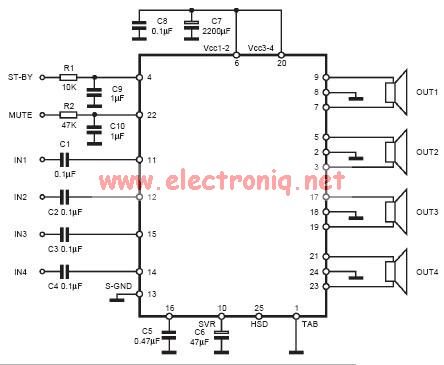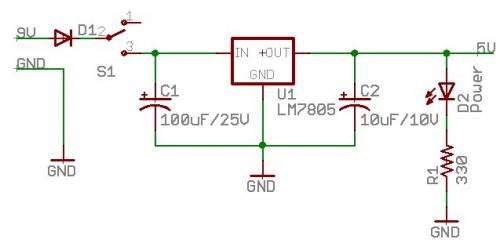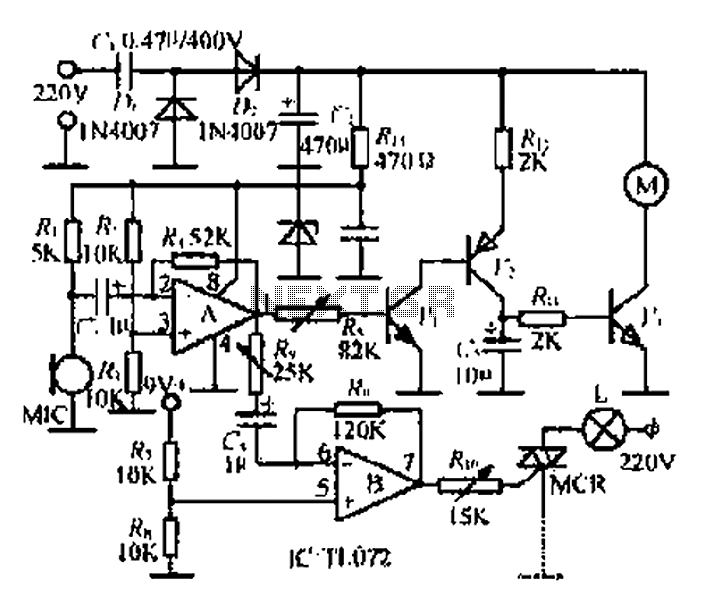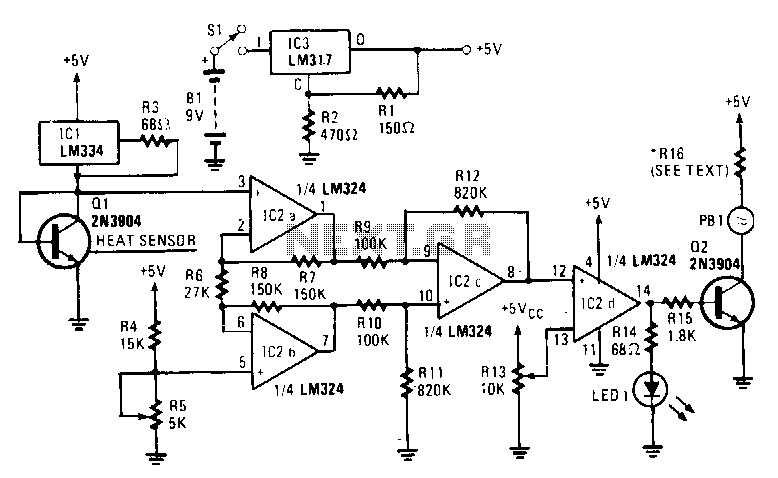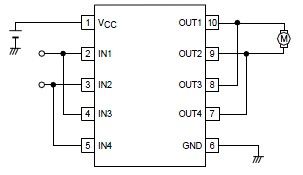
Electronic Door Release
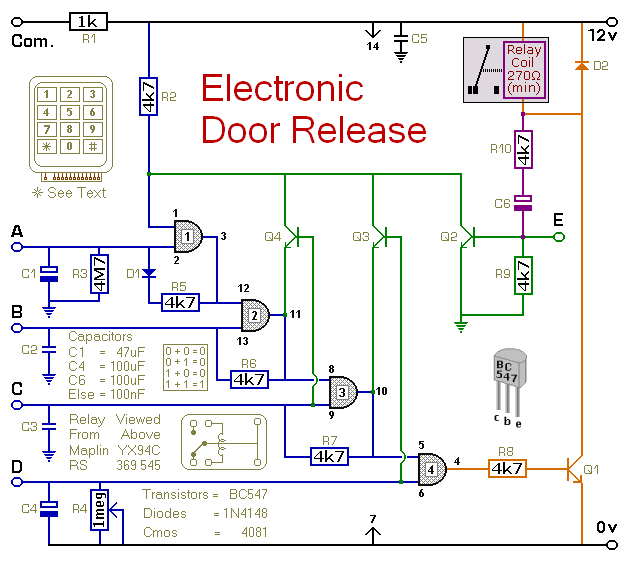
This circuit is designed to operate an electrical door-release mechanism, but it can be utilized for various other applications. Users can enter a four-digit code of their choice, after which the relay will energize for a duration determined by the values of capacitor C4 and resistor R4. The relay contacts are utilized to power the release mechanism, and the standby current is nearly zero, making battery power a viable option. The circuit operates with a 12-volt supply but is compatible with voltages ranging from 5 to 15 volts. It is essential to select a relay that matches the desired supply voltage. For specific applications, the SPCO/SPDT relay can be replaced with a multi-pole relay. However, the on-board relay should not be used to switch mains voltage due to inadequate isolation between the relay contacts and the low-voltage components. For mains voltage switching, a suitably rated relay should be mounted away from the board for safety. The circuit allows users to choose four keys to form their code, which are connected to terminals labeled "A," "B," "C," and "D." The common terminal is connected to resistor R1, while the remaining keys are connected to terminal "E." When the correct sequence of four keys is pressed, the relay energizes. With the specified values for C4 and R4, and with R4 set to its maximum, the relay will de-energize approximately one minute after releasing key "D." Alternatively, replacing C4 with a 100nF capacitor and R4 with a 4.7kΩ fixed resistor will cause the relay to de-energize immediately upon releasing "D." Any keys not connected to "A," "B," "C," or "D" are linked to the base of transistor Q2. If any of these incorrect keys are pressed, Q2 will pull pin 1 low, resulting in a failed code entry. Similarly, pressing "C" or "D" out of sequence will cause transistors Q3 or Q4 to pull pin 1 low, leading to a failed entry. In case of a mistake during code entry, users can simply restart the process. The keypad must be of the type with a common terminal and individual connections for each key, typically featuring 13 terminals for a 12-key pad. Matrix-type keypads with 7 or 8 terminals are not suitable. A 12-key pad includes eight "wrong" keys connected to terminal "E." For enhanced security, a larger keypad with additional "wrong" keys can be employed. The support material for this circuit includes a step-by-step guide for constructing the circuit board, a parts list, and a detailed circuit description.
This circuit utilizes a microcontroller or a simple logic circuit to interpret the key presses from the keypad. The microcontroller is programmed to recognize the specific sequence of key presses that constitute the valid code. The relay, which can be a standard electromagnetic relay or a solid-state relay, is responsible for controlling the power to the door-release mechanism.
The power supply section of the circuit can include a voltage regulator if the input voltage exceeds the required levels for the microcontroller and other components. The use of decoupling capacitors near the power pins of the microcontroller ensures stable operation by filtering out noise.
To enhance user experience, an audible or visual indicator, such as a buzzer or LED, can be added to provide feedback on code entry success or failure. The design can also incorporate a timeout feature, where the system resets after a certain period of inactivity, further improving security and usability.
For assembly, the circuit board should be designed with careful attention to the layout, ensuring that the high-voltage relay is adequately isolated from sensitive low-voltage components. Proper trace widths and clearance should be maintained to prevent accidental short circuits and ensure reliable operation.
In summary, this circuit not only provides a secure method for controlling an electrical door-release mechanism but also offers flexibility for adaptation to various applications, making it a versatile choice for electronic projects.This circuit is designed to operate an electrical door-release mechanism - but it will have other applications. Enter the four-digit code of your choice - and the relay will energize for the period of time set by C4 & R4.
Use the relay contacts to power the release mechanism. The standby current is virtually zero - so battery power is a realistic option. The circuit is drawn with a 12-volt supply - but it will work at anything from 5 to 15-volts. All you have to do is choose a relay suitable for the supply voltage you want to use. Replace the SPCO/SPDT relay with a multi-pole relay - if it suits your application. Do not use the "on-board" relay to switch mains voltage. The board`s layout does not offer sufficient isolation between the relay contacts and the low-voltage components. If you want to switch mains voltage - mount a suitably rated relay somewhere safe - Away From The Board.
Choose the four keys you want to use as your code - and connect them to "A B C & D". Wire the common to R1 and all the remaining keys to "E". When you press your four keys - in the right order - the relay will energize. With the values of C4 & R4 as shown - and with R4 set to its maximum - the relay will de-energized about one minute after "D" is released. However - if you replace C4 with a 100nF capacitor - and replace R4 with a 4k7 fixed resistor - the relay will de-energize the moment "D" is released.
Any keys not wired to "A B C & D" are connected to the base of Q2. Whenever one of these "Wrong" keys is pressed - Q2 takes pin 1 low and the code entry fails. Similarly, if "C" or "D" is pressed out of sequence - Q4 or Q3 will take pin 1 low and the code entry will fail. If you make a mistake while entering the code - simply start again. The Keypad must be the kind with a common terminal and a separate connection for each key. On a 12-key pad, look for 13 terminals. The matrix type with 7 or 8 terminals will NOT do. A 12-key pad has eight "Wrong" keys connected to "E". If you need a more secure code - use a bigger keypad with more "Wrong" keys. The Support Material for this circuit includes a step-by-step guide to the construction of the circuit board, a parts list, a detailed circuit description and more.
🔗 External reference
This circuit utilizes a microcontroller or a simple logic circuit to interpret the key presses from the keypad. The microcontroller is programmed to recognize the specific sequence of key presses that constitute the valid code. The relay, which can be a standard electromagnetic relay or a solid-state relay, is responsible for controlling the power to the door-release mechanism.
The power supply section of the circuit can include a voltage regulator if the input voltage exceeds the required levels for the microcontroller and other components. The use of decoupling capacitors near the power pins of the microcontroller ensures stable operation by filtering out noise.
To enhance user experience, an audible or visual indicator, such as a buzzer or LED, can be added to provide feedback on code entry success or failure. The design can also incorporate a timeout feature, where the system resets after a certain period of inactivity, further improving security and usability.
For assembly, the circuit board should be designed with careful attention to the layout, ensuring that the high-voltage relay is adequately isolated from sensitive low-voltage components. Proper trace widths and clearance should be maintained to prevent accidental short circuits and ensure reliable operation.
In summary, this circuit not only provides a secure method for controlling an electrical door-release mechanism but also offers flexibility for adaptation to various applications, making it a versatile choice for electronic projects.This circuit is designed to operate an electrical door-release mechanism - but it will have other applications. Enter the four-digit code of your choice - and the relay will energize for the period of time set by C4 & R4.
Use the relay contacts to power the release mechanism. The standby current is virtually zero - so battery power is a realistic option. The circuit is drawn with a 12-volt supply - but it will work at anything from 5 to 15-volts. All you have to do is choose a relay suitable for the supply voltage you want to use. Replace the SPCO/SPDT relay with a multi-pole relay - if it suits your application. Do not use the "on-board" relay to switch mains voltage. The board`s layout does not offer sufficient isolation between the relay contacts and the low-voltage components. If you want to switch mains voltage - mount a suitably rated relay somewhere safe - Away From The Board.
Choose the four keys you want to use as your code - and connect them to "A B C & D". Wire the common to R1 and all the remaining keys to "E". When you press your four keys - in the right order - the relay will energize. With the values of C4 & R4 as shown - and with R4 set to its maximum - the relay will de-energized about one minute after "D" is released. However - if you replace C4 with a 100nF capacitor - and replace R4 with a 4k7 fixed resistor - the relay will de-energize the moment "D" is released.
Any keys not wired to "A B C & D" are connected to the base of Q2. Whenever one of these "Wrong" keys is pressed - Q2 takes pin 1 low and the code entry fails. Similarly, if "C" or "D" is pressed out of sequence - Q4 or Q3 will take pin 1 low and the code entry will fail. If you make a mistake while entering the code - simply start again. The Keypad must be the kind with a common terminal and a separate connection for each key. On a 12-key pad, look for 13 terminals. The matrix type with 7 or 8 terminals will NOT do. A 12-key pad has eight "Wrong" keys connected to "E". If you need a more secure code - use a bigger keypad with more "Wrong" keys. The Support Material for this circuit includes a step-by-step guide to the construction of the circuit board, a parts list, a detailed circuit description and more.
🔗 External reference
